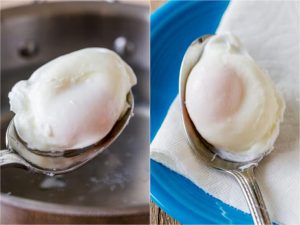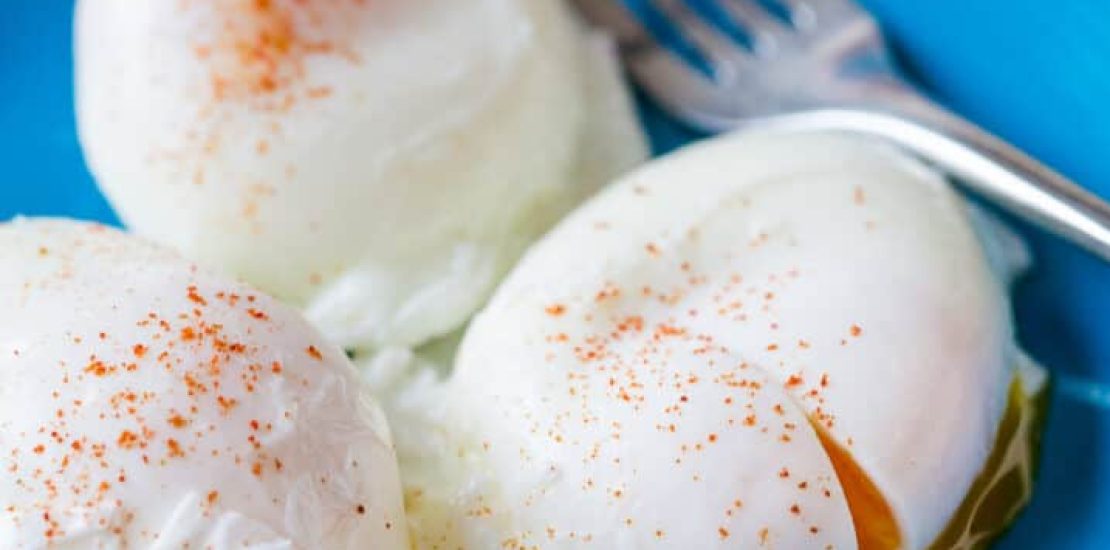Poached eggs can be a delightful addition to a variety of dishes, from classic Eggs Benedict to a simple avocado toast. Achieving the perfect poached egg requires a bit of practice, but with the right technique, you can consistently produce eggs with a runny yolk and a tender white. Here’s a step-by-step recipe along with some important notes to help you make poached eggs perfectly every time:

Ingredients:
- Fresh eggs (as many as you need)
- Water
- Vinegar (optional, helps coagulate the egg whites)
Equipment:
- Deep saucepan or pot
- Slotted spoon
- Timer or watch
Instructions:
- Choose Fresh Eggs: Fresh eggs tend to hold their shape better when poaching. If possible, use eggs that are not too old.
- Bring Water to a Simmer: Fill a deep saucepan or pot with water, about 2 to 3 inches deep. Heat the water over medium-low heat until it reaches a gentle simmer. You should see small bubbles forming at the bottom of the pot, but the water should not be boiling vigorously.
- Add Vinegar (Optional): Adding a splash of vinegar (white or apple cider vinegar) to the simmering water can help the egg whites coagulate more quickly and maintain their shape. Use about a tablespoon of vinegar per cup of water.
- Crack Eggs into Separate Bowls: Crack each egg into a separate small bowl or ramekin. This makes it easier to slide the egg into the water smoothly and avoid breaking the yolk.
- Create a Gentle Whirlpool: Use a spoon to gently stir the simmering water in a circular motion. This creates a whirlpool effect that will help the egg white wrap around the yolk and form a neat shape.
- Slide Eggs into the Water: Hold the bowl with the cracked egg just above the water’s surface and gently slide the egg into the center of the whirlpool. The swirling water will help the egg white envelop the yolk.
- Set Timer: Set a timer for about 3 to 4 minutes for a runny yolk, or longer if you prefer a firmer yolk.
- Lift Eggs Out of Water: Use a slotted spoon to gently lift the poached eggs out of the water. You can check the doneness by gently touching the egg whites; they should feel firm but not hard.
- Drain Excess Water: Place the poached eggs on a paper towel or clean kitchen towel to drain any excess water.
- Season and Serve: Season the poached eggs with a sprinkle of salt and pepper, and serve them immediately. They are wonderful on toast, English muffins, salads, or as part of various dishes.
Notes:
- Water Temperature: It’s important to maintain a gentle simmer and not a rolling boil, as vigorous boiling can cause the eggs to break apart.
- Fresh Eggs: Fresher eggs tend to hold their shape better. If you’re concerned about egg freshness, you can test an egg’s freshness by placing it in a bowl of water. A fresh egg will sink, while a less fresh egg will float.
- Vinegar: While vinegar is optional, it can help the egg whites coagulate more quickly. However, be cautious not to use too much vinegar, as it can affect the taste of the eggs.
- Egg Handling: Crack each egg into a separate bowl before adding it to the water. This prevents shells from getting into the poaching water and allows for smoother egg placement.
- Whirlpool Technique: The whirlpool technique helps the egg white wrap around the yolk, but don’t swirl the water too aggressively, as this can cause the egg white to break apart.
- Cooking Time: Adjust the cooking time to achieve your preferred level of yolk doneness. Experiment with timing to find your perfect poached egg.
- Variations: Feel free to get creative with your poached eggs by adding them to various dishes like avocado toast, salads, or incorporating them into different recipes.
Remember, achieving the perfect poached egg might take a bit of practice, so don’t be discouraged if your first few attempts aren’t flawless. With time, you’ll develop a sense of timing and technique that works best for you.
Of course! Here are some additional tips and troubleshooting suggestions to help you master the art of poaching eggs:
Troubleshooting:
- Egg Spreading: If your poached eggs tend to spread out in the water, it might be because the water isn’t simmering gently enough. Make sure the water is at a low simmer, not a rolling boil.
- Egg Sticking to Pot: To prevent the eggs from sticking to the bottom of the pot, you can gently stir the water before adding the eggs. This will help create a smoother water surface.
- Ragged Egg Whites: If the egg whites are feathering or look ragged, it could be due to using older eggs or the water being too hot. Try using fresh eggs and adjusting the water temperature to a gentler simmer.
- Yolk Consistency: Achieving the perfect yolk consistency can take practice. If you prefer a firmer yolk, increase the cooking time by a minute or so. For a runnier yolk, reduce the cooking time slightly.
Advanced Techniques:
- Sous Vide Poaching: For a more precise and consistent result, you can try poaching eggs using a sous vide machine. This method involves sealing eggs in vacuum-sealed bags and cooking them in a water bath at a specific temperature.
- Egg Poaching Pods: There are special egg poaching pods or silicone molds available that can help shape the eggs as they cook. These can be especially helpful if you’re looking for perfectly uniform poached eggs.
- Batch Poaching: If you’re cooking for a crowd, you can poach multiple eggs at once by using a larger pot and creating separate whirlpools for each egg. This method requires more practice and coordination.
Creative Serving Ideas:
- Eggs Benedict: Serve your poached eggs on English muffins with Canadian bacon or smoked salmon, topped with hollandaise sauce.
- Avocado Toast: Place poached eggs on top of toasted whole-grain bread spread with mashed avocado. Season with salt, pepper, and red pepper flakes.
- Salads: Add poached eggs to salads for a protein boost and a rich, runny yolk dressing.
- Ramen or Noodle Soups: Drop poached eggs into warm bowls of ramen or noodle soups just before serving for added flavor and richness.
- Polenta or Grits: Place a poached egg over a bed of creamy polenta or grits for a comforting and hearty dish.
- Grain Bowls: Incorporate poached eggs into grain bowls along with roasted vegetables, grains, and a drizzle of sauce.
Remember, practice makes perfect when it comes to poaching eggs. Don’t be discouraged if your first few attempts aren’t flawless. With time and experimentation, you’ll find the techniques that work best for you and your desired level of yolk doneness. Enjoy your culinary journey into the world of perfectly poached eggs!


